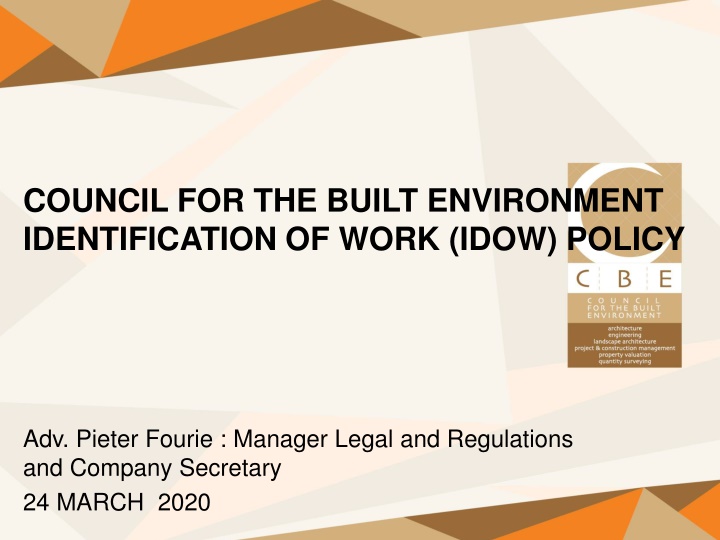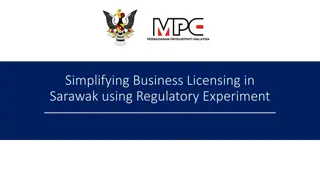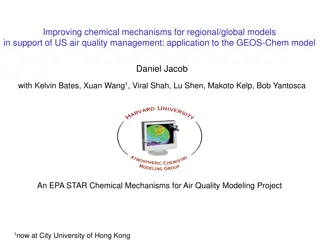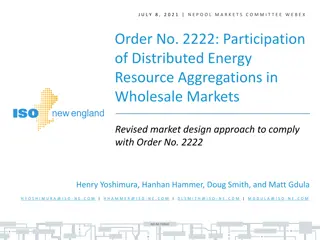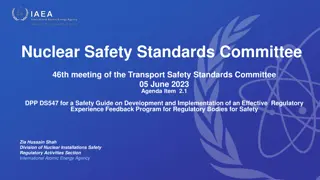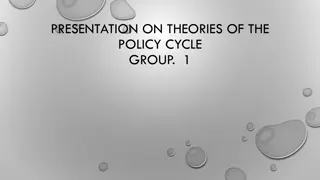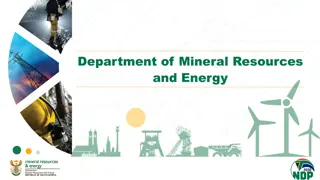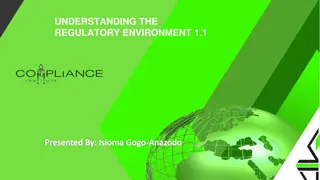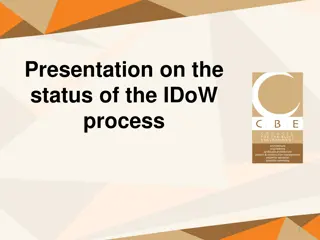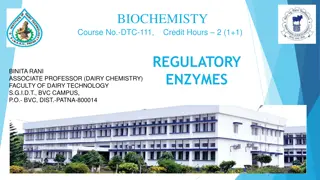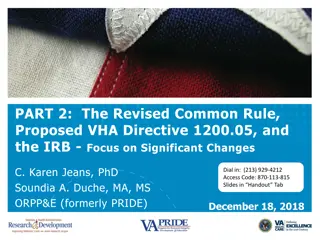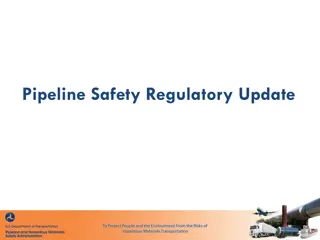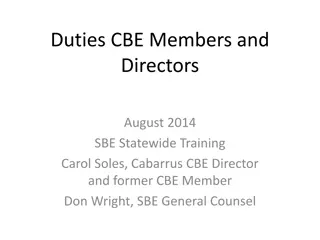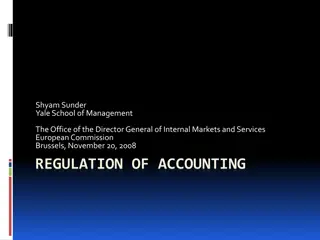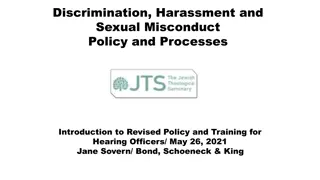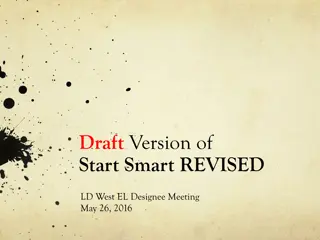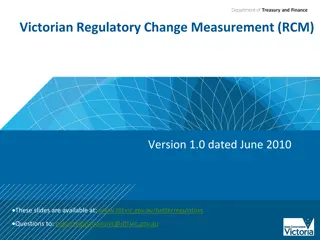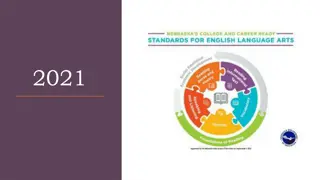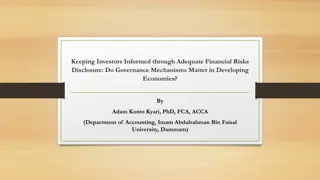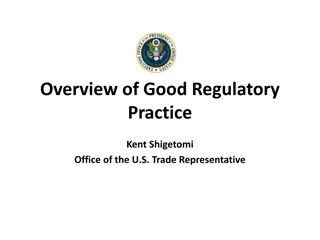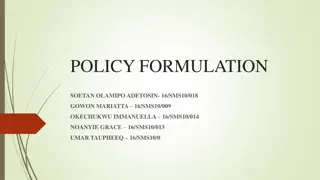CBE's Revised IDoW Policy for Regulatory Mechanisms
This presentation by the Council for the Built Environment (CBE) outlines the Identification of Work (IDoW) Policy, elucidating key regulatory mechanisms, acronyms, definitions, and the role of the CBE in implementing and evaluating such mechanisms in the built environment sector. The purpose is to expound on the revised policy for a better understanding of regulatory requirements and transformation initiatives.
Download Presentation

Please find below an Image/Link to download the presentation.
The content on the website is provided AS IS for your information and personal use only. It may not be sold, licensed, or shared on other websites without obtaining consent from the author.If you encounter any issues during the download, it is possible that the publisher has removed the file from their server.
You are allowed to download the files provided on this website for personal or commercial use, subject to the condition that they are used lawfully. All files are the property of their respective owners.
The content on the website is provided AS IS for your information and personal use only. It may not be sold, licensed, or shared on other websites without obtaining consent from the author.
E N D
Presentation Transcript
COUNCIL FOR THE BUILT ENVIRONMENT IDENTIFICATION OF WORK (IDOW) POLICY Adv. Pieter Fourie : Manager Legal and Regulations and Company Secretary 24 MARCH 2020
CONTENT Acronyms Definitions Introduction Background Problem Statement Regulation of Professions The Identified Scope of Work as part of the Regulatory Mechanisms Key Requirements of Regulatory Mechanisms Mechanisms to enable entrance into professions Protection of Professional Title Transformation in the Built Environment The role of the CBE to Implement, Monitor and Evaluate Regulatory Mechanisms Review of the Identification of Work Policy
PURPOSE The purpose of this concise presentation is to explain the CBE s revised IDoW Policy with the Key Requirements of Regulatory Mechanisms.
ACRONYMS BE Built Environment CBE Council for the Built Environment CBEP Council for the Built Environment CC Competition Commission DPWI Department of Public Works and Infrastructure ECSA Engineering Council of South Africa IDoW Identification of Work PAJA Promotion of Administrative Justice Act SACAP South African Council for the Architectural Profession SACLAP South African Council for the Landscape Architectural Profession SACPCMP South African Council for the Project Construction and Management Professions SACPVP South African Council for the Property Valuers Profession SACQSP South African Council for the Quantity Surveyors Profession
DEFINITIONS Council for the professions "means the: South African Council for the Architectural Profession, established by the Architectural Profession Act, 2000; South African Council for the Project and Construction Management Professions, established by the Project and Construction Management Professions Act, 2000; Engineering Council of South Africa, established by the Engineering Profession Act, 2000; South African Council for the Landscape Architectural Profession, established by the Landscape Architectural Profession Act, 2000; South African Council for the Property Valuers Profession, established by the Property Valuers Profession Act, 2000; and South African Council for the Quantity Surveying Profession, established by the Quantity Surveying Profession Act, 2000;
DEFINITIONS Professions Acts refer to the: Architectural Profession Act (Act No. 44 of 2000); Engineering Profession Act (Act No. 46 of 2000); Landscape Architectural Profession Act (Act No. 45 of 2000); Project and Construction Management Professions Act (Act No. 48 of 2000); Property Valuers Profession Act (Act No. 47 of 2000); and Quantity Surveying Profession Act (Act No. 49 of 2000); CBE Act Council for the Built Environment Act (Act No. 43 of 2000); CBE The Council for the Built Environment, established in terms of the CBE Act;
DEFINITIONS CBEP Category Means a council for a built environment profession established in terms any of the professions Acts, and in a given context, all six councils so established; refers specifically to the categories in which a person may register as prescribed by the council regulating the profession under which they fall; a person who has in respect of the work or task to be performed, the required knowledge, training, experience, and where applicable, qualifications specific to that work or task, and competency have a similar meaning; Competent person Identification of work is the identification of the scope of work for each category of registration by the CBE in terms of section 20(2) of the CBE Act; means regularly and consistently carrying out work; Practice means a person who is registered as such in terms of any of the professions Acts; Professional
DEFINITIONS means a person registered in terms of any of the Registeredperson Professions Acts; the process of assessment of competency of applicants Registration and of entering the names of suitably qualified (competent) persons as professionals, candidates and specified category persons into an official register, kept according to categories that specify the professional areas in which registered persons are competent to practice; and that allows registered persons to use a specific title that serves as indication of competency to members of the public.
INTRODUCTION The Council for the Built Environment (the CBE) is a statutory body established in terms of the Council for the Built Environment Act, 43 of 2000 (the CBE Act). The CBE is an entity of the Department of Public Works and Infrastructure (DPWI). The CBE is an overarching body, regulating the activities of the six councils for the following built environment professions: engineering, architecture, landscape architecture, quantity surveying, property valuation and project and construction management. The CBE Act impels the CBE to, after consultation with the Competition Commission (CC) and in consultation with the Councils for the Built Environment Professions (the CBEP), identify the scope of work for each category of registration (section 20 of the CBE Act). This policy is replacing the previous CBE IDoW Policy issued in December 2009. The purpose of this policy is to guide the CBEP in regulating their professions.
BACKGROUND The Built Environment (BE) is defined as the physical world that has been intentionally created through science and technology for the benefit of humankind. Parliament, in recognition of the crucial role that built environment professionals play in South African society, passed seven Acts in 2000 to regulate six CBEP. These were for architecture, engineering, landscape architecture, project and construction management, property valuation and quantity surveying and for the CBE as an overarching body over the activities of said six CBEP, and its core objectives include: The objects of the council are to - a) promote and protect the interests of the public in the built environment; b) promote and maintain a sustainable built environment and natural environment; c) promote ongoing human resource development in the built environment; d) facilitate participation by the built environment professions in integrated development in the context of national goals; e) promote appropriate standards of health, safety and environmental protection within the built environment; f) promote sound governance of the built environment professions;
BACKGROUND g) promote liaison in the built environment in the field of training, both in the Republic and elsewhere, and to promote the standards of such training in the Republic h) serve as a forum where the representatives of the built environment professions may discuss the relevant - (i) required qualifications; (ii) standards of education; (iii) training and competence; (iv) promotion of professional status; and (v) legislation impacting on the built environment; and (vi) ensure the uniform application of norms and guidelines set by the CBEP throughout the built environment.
BACKGROUND The core mandates of the CBEP are to accredited built environment educational programs at educational institutions, register applicants in a category of registration and oversee the professional conduct of registered persons. Considering the CBE and CBEP mandates, the following concurrent functions have been identified: 1. Identification of Work 2. Guideline Professional Fees 3. Continuous Professional Development 4. Accreditation of Built Environment Programmes 5. Code of Conduct for the Professions 6. Professional Registration 7. Recognition of Voluntary Associations 8. Recognition of New Professions 9. International Agreements 10. Recognition of Prior Learning 11. Standard Generating 12. Appeals and Tribunals 13. Competency Standards for Registrations A result of agreeing on concurrent functions is that the CBE will oversee, to ensure consistent application of policies by the CBEP.
PROBLEM STATEMENT The CBE is impelled by the CBE Act to, after consultation with the Competition Commission (the CC), and in consultation with the six CBEP, identify the scope of work for each category of registration. This process is loosely referred to as the IDoW Process. It is paramount to the statutory duty of CBEP to regulate their professions, as the scope of work is identified as the range or extent of work to be done by a person registered in that category . A holistic consideration of the enabling legislation confirms that the IDoW is a component of a set of mechanisms utilised to regulate the built environment professions.
PROBLEM STATEMENT IDoW Process as per the CBEP Acts and the CBE Act are depicted in the following diagram: Section 26/27 (1) of the Professions Acts: The council must consult with (a) all voluntary associations; (b) any person; (c) any body; or (d) any industry, that may be affected by any laws regulating the built environment professions regarding the identification of the type of work which may be performed by persons registered in any of the categories referred to in section 18, including work which may fall within the scope of any other profession regulated by the professions Acts referred to in the Council for the Built Environment Act, 2000. Section 20 (2) of the CBE Act The council must, after consultation with the Competition Commission, and in consultation with the councils for the professions, identify the scope of work for every category of registered persons. Section 26/27 (2) of the Professions Act: After the process of consultation the council must submit recommendations to the CBE regarding the work identified in terms of subsection (1), for its consideration and identification in terms of section 20 of the Council for the Built Environment Act, 2000. Section 20 (1) of the CBE Act The council must, after receipt of the recommendations of the councils for the professions submitted to it in terms of the professions Acts, and before liaising with the Competition Commission in terms of section 4(q) (a) determine policy with regard to the identification of work for the different categories of registered persons; (b) consult with any person, body or industry that may be affected by the identification of work in terms of this section.
PROBLEM STATEMENT IDoW Implementation Obligations (Based on legislation and respective regulatory mandates). 1. CBEP recommend to CBE the type of work to be performed by each category of registration after consultation with VAs and industry 3. CBE, after consultation with CC and in consultation with CBE, identifies the scope of work for each category of registration 7. CBE develops a monitoring Evaluation program based on CBEP' Implementation Plan 4. CBE to develop overching IDoW policy to guide implementation by CBEP 5. CBE develop IDoW Policies based on principles in CBEP overching policy 6. CBEP provide Implementation plan to CBE for consultation 2. CBE develops policy on IDoW
REGULATION OF PROFESSIONS The CC has acknowledged the mandate of the CBEP to regulate their respective professions. There are deemed to be various codes and policies, which, if applied in combination, will form an overarching mechanism for the regulation of professions (hereafter referred to as regulatory mechanisms). The regulation of the professions should include mechanisms to ensure seamless entrance into the professions. Regulation therefore by no means suggest the exclusion of competent persons from the performing of work. Regulatory mechanisms are not intended to a restrictive, but rather enabling.
THE IDENTIFIED SCOPE OF WORK AS PART OF THE REGULATORY MECHANISMS The scope of work is defined as the range or extent of the work to be performed by a person registered in that category . This mechanism is strongly directed towards informing the user of built environment professional services. The different categories of registration are informed by the required academic qualifications and competence (including experience gained).
KEY REQUIREMENTS OF REGULATORY MECHANISMS The CBEP must develop a regulatory framework once the work has been scoped to address the following: The knowledge and competence required to carry out the identified work and to determine which level of professional can undertake the work. This will be based on: clearly defined competencies specifying if they are work-based or worker- based competencies; the ranking of complexity by the profession and the skills required for each complexity level must be indicated; the impact of the work and risks associated with non-performance or poor performance must be stated; There must be a clear correlation between the cost of the work and skills/abilities required to carry it out.
KEY REQUIREMENTS OF REGULATORY MECHANISMS Identify the persons competent to carry out the work using the following criteria: Educational level the appropriate NQF levels should be identified, but provision should also be made for the recognition of prior learning and experience; Relevant experience to be determined based on relevant work done; Skills level additional examinations may be determined by the relevant CBEP; Proof of continuing professional development. Provide a guideline on how to regulate the professional conduct of persons who are competent to carry out the work without been registered. Provide a guideline on how to deal with overlaps in identified work between two or more professions. Provide mechanisms to migrate from one category of registration to the next
MECHANISMS TO ENABLE ENTRANCE INTO PROFESSIONS The following mechanisms will be introduced to enable registration in accordance with registration requirements where persons performing identified work do not comply with registration requirements: Special Consent: This is a mechanism for a CBEP to grant, on application, permission for a registered person to undertake a type of project that is not identified for his/her particular category of registration. Limited Special Dispensation: Any registered person who intended to undertake work outside his or her category of l registration, may apply for Limited Special Dispensation by submitting a portfolio of evidence to prove skills and competence in order to be specifically exempted.
MECHANISMS TO ENABLE ENTRANCE INTO PROFESSIONS Recognition of Prior Learning (RPL): is a process through which the previous learning and experience of a learner, however obtained, against the learning outcomes required for a specific qualification and the acceptance for the purposes of qualification of that which meets those requirements. Candidacy: Is a process during which a person, registered in the candidate category, receives training and gain experience through employment with the intention of attaining the competence required for professional registration. Transitional arrangements: Persons registered in categories and who are performing work not identified in the scope of work of that category, may continue to perform such work until an effective date determined and published by the relevant CBEP.
PROTECTION OF PROFESSIONAL TITLE The CBEP must prescribe mechanisms to protect the use of authorised titles only by persons registered in the applicable category.
TRANSFORMATION IN THE BUILT ENVIRONMENT Transformation of the built environment is a core priority of the CBE and CBEP and is foremost in all strategies, including the regulation of professions. The CBE acknowledges the CC s role to enhance transformation through the application of the Competition Act and fully prescribes to those principles of the Competition Act .The following is adopted as the cornerstone of regulation of the BE professions: Competition Act - Preamble The people of South Africa recognise: That apartheid and other discriminatory laws and practices of the past resulted in excessive concentrations of ownership and control within the national economy, inadequate restraints against anticompetitive trade practices, and unjust restrictions on full and free participation in the economy by all South Africans. That the economy must be open to greater ownership by a greater number of South Africans.
TRANSFORMATION IN THE BUILT ENVIRONMENT That credible competition law, and effective structures to administer that law, are necessary for an efficient functioning economy. That an efficient, competitive economic environment, balancing the interests of workers, owners and consumers and focussed on development, will benefit all South Africans in order to provide all South Africans equal opportunity to participate fairly in the national economy; achieve a more effective and efficient economy in South Africa; provide for markets in which consumers have access to, and can freely select, the quality and variety of goods and services they desire; create greater capability and an environment for South Africans to compete effectively in international markets; restrain particular trade practices which undermine a competitive economy;
TRANSFORMATION IN THE BUILT ENVIRONMENT regulate the transfer of economic ownership in keeping with the public interest; establish independent institutions to monitor economic competition; and give effect to the international law obligations of the Republic. The purpose of this Act is to promote and maintain competition in the Republic in order to promote the efficiency, adaptability and development of the economy; to provide consumers with competitive prices and product choices; to promote employment and advance the social and economic welfare of South Africans; to expand opportunities for South African participation in world markets and recognise the role of foreign competition in the Republic; to ensure that small and medium-sized enterprises have an equitable opportunity to participate in the economy; and to promote a greater spread of ownership, in particular to increase the ownership stakes of historically disadvantaged persons.
THE ROLE OF THE CBE TO IMPLEMENT, MONITOR AND EVALUATE REGULATORY MECHANISMS The CBE will undertake appropriate actions to implement this policy, including providing information on the policy to the CBEP and other stakeholders and guidance in executing it. The CBE will monitor and evaluate implementation of the policy to determine its effectiveness. Monitoring and evaluation takes two forms: the monitoring and evaluation of the implementation of identification of work; and the monitoring and evaluation of the process of regulating the professional conduct of registered and unregistered persons.
REVIEW OF THE IDENTIFICATION OF WORK POLICY This identification of Work Policy shall be reviewed on an annual basis, or more frequently if required.
